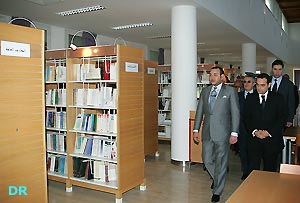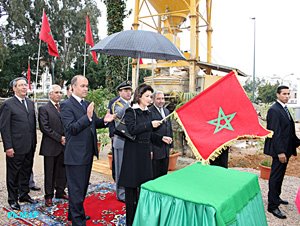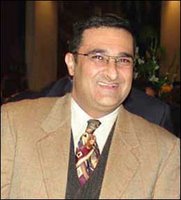Two more Moroccan women died following the injuries they sustained in a stampede on Thursday that occurred during hajj stoning ritual in Mina, bringing to four the number of Moroccan victims, said Moroccan Ministry of Habous and Islamic Affairs.
The day before, the Ministry of Habous and Islamic Affairs announced the death of two Moroccan women in Mina stampede that killed another 345 pilgrims.
See also: Hajj Tragedy. Stampede kills 345 pilgrims

On Friday in Asilah, King Mohammed VI inaugurated the Prince Bandar Bin Sultan library.The project was suggested in 1997 by former Saudi Arabian ambassador to the United States, Prince Bandar Bin Sultan, who was taking part in the cultural festival of Asilah, and late king Hassan II decided to call it: "Prince Bandar Bin Sultan library".
Built on 5,000 square meters, the library houses three conference rooms, a restaurant, a children's room, a newspapers' room, a manuscripts service, a cyber-café and a reading room.
Worth USD 9mn, the library is equipped with high-tech means of communication to provide searchers with means to communicate with the most renowned world libraries via satellite network.
The library, which will host various cultural activities, houses an auditorium for great events (650 seats) equipped with high-tech projection and translation techniques in four languages.

In Rabat on Friday Princess Lalla Meryem, sister of king Mohammed VI, launched the construction of the National Museum of Cotemporary Arts. The project, worth USD 8mn, is meant to offer a space of dialogue between the public and artists and sensitize and initiate larger public to art creation. The museum, which will be built on 6,813 square meters, will aim at preserving the Moroccan cultural landscape and exhibiting it for coming generations.
Morocco and India have signed a cooperation agreement in low-cost social housing.
Signed by Moroccan minister of Housing and Urbanism, Toufiq Hjira and Indian minister of Urban Employment and Poverty Alleviation, Komari Selja, the agreement provides for promoting scientific and technical training, developing information and geographical systems (SIG) and intervention methods to fight unhealthy housing.
The agreement also provides for the creation of a Moroccan center of research and studies in low-cost social housing and the promotion of a micro-finance system to finance social housing.
The two ministers agreed on a joint action plan for 2006-2007 and voiced hope to promote their cooperation in this field.
Komari Selja arrived Friday on an official visit to Morocco.
"A culture based on honesty, professionalism, transparency and dialogue..."
 In yet another positive sign that the Moroccan media is moving to more freedom of reporting and comment, General Manager of the National Company for Radio and Television (SNRT) Faiçal Laâraïchi affirmed that his institution has "the duty" of providing information on the government's actions in favour of the citizens.
In yet another positive sign that the Moroccan media is moving to more freedom of reporting and comment, General Manager of the National Company for Radio and Television (SNRT) Faiçal Laâraïchi affirmed that his institution has "the duty" of providing information on the government's actions in favour of the citizens.In an interview with the Moroccan daily Libération, Laâraïchi said that one of the missions of the SNRT consists of informing the general public on what happens in Morocco.
The High Authority of Communication and Audiovisual (HACA) approved on Monday the SNRT's specifications which gives a precise definition of the mission of the former Moroccan Radio and Television (RTM).
“If we do not cover the official and parliamentary activities, etc, who will do it?" Laâraïchi asked, adding that it is the role of the SNRT to inform the public as part of a proximity approach.
Evoking the charter envisaged by the SNRT's specifications, Laâraïchi considered that it represents a fundamental platform for a radio and television company, enabling it to have a culture based on honesty, professionalism, transparency and dialogue.
"In our job, when the data is processed, one needs to be very objective. Objectivity is not innate. It is an exercise," he said, expressing his determination that plurality is expressed in a clear and transparent way on the TV.
Laâraïchi stressed that the SNRT will not be "an instrument of propaganda but a means of free expression and plurality, noting that the approval of the SNRT's specifications is among the many reforms which marked the beginning of the 21st century in Morocco.
"We had to change the legal statute to meet these challenges and the SNRT's specifications come to define our mission and the resources that we can have in the future," he noted.
In an interview with the same newspaper, the president of the High Authority of Communication and Audiovisual (HACA), Ahmed Ghazali, praised the experience accumulated by his authority in terms of regulation and guarantees for pluralism.
"We will continue in this way and give more institutional, normative and behavioural visibility so that the media operators as well as the political and civil society know that the issue is about determining the development of our country," Ghazali pointed out.
Concerning the political parties' access to TV before the HACA undergoes the pressure of the 2007 election, Ghazali stressed that the authority has been working on this issue for more than a year.
“A working group in charge of this dossier has set up the general guidelines and that of formalisation in terms of principles and rules,” Ghazali said.
Tags: Morocco, Fès, Maghreb, news

1 comment:
moladi a South African Company has developed a one-step casting process for the erection of homes,”…Simply cast a whole house in a day, employing unskilled labour, reducing time, waste and cost. Eliminating chasing for plumbing and electrical pipe work, plastering and beam filling. Resulting in a wall stronger than brick that is earthquake resistant. A cost effective, holistic design and build technology that far outweighs poorly designed costly concrete-block and masonry structures…”
www.moladi.com
Post a Comment